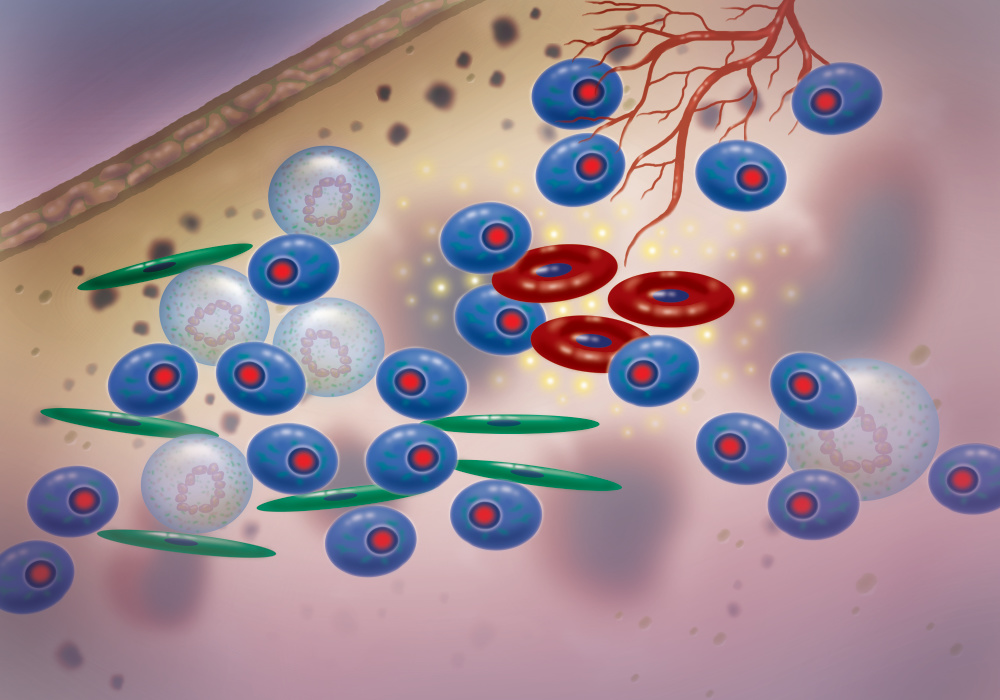- A finding by Dana-Farber researchers may help explain why myeloma often rebounds after drug treatment.
- The research also suggests combinations of drugs that can prevent such recurrence.
The process of converting genetic information from DNA to RNA, known as transcription, is a joint undertaking. Sections of DNA, known as promoters, collaborate with other sections known as enhancers to recast the genetic code into a form that can be used by cells to make proteins.
As with many partnerships, however, it hasn’t been clear whether the participants always act in sync—whether promoters and enhancers control the same sets of genes or different ones. The question is of more than theoretical interest.
One of the hallmarks of a cancer cell is a frenzy of transcription, in which genes spew a constant stream of orders to grow and divide. If promoters and enhancers play separate roles in this tumult, it may not be enough to block one or the other of them with a targeted drug. It may be necessary to block them both for maximal anti-cancer effect.
A recent study by Dana-Farber scientists makes a case for the latter scenario. As described in Cell Reports, researchers led by Nikhil Munshi, MD, and Mariateresa Fulciniti, PhD, found two distinct systems for controlling promoters and enhancers in multiple myeloma. The finding may, on the one hand, help explain why myeloma often rebounds after drug treatment (therapies that stymie just one control mechanism are likely to deal the disease a setback, not a total defeat), and suggest combinations of drugs that can prevent such recurrence.

“Cancer is driven, fundamentally, by the expression of genes—by the process of transcribing DNA into RNA and using that as the basis for making proteins. As normal cells transform into cancer cells, the protein-producing program is perturbed,” explains Munshi, director of Basic and Correlative Science at Dana-Farber’s Jerome Lipper Multiple Myeloma Center. “The normal control of transcription into RNA breaks down, allowing cells to proliferate abnormally. We wanted to explore the relationship between enhancers and promoters in multiple myeloma to determine whether they function as a single gene-control system or a two-pronged one.”
Although they work closely in switching genes on and off, enhancers and promoters are not neighbors in the coiled expanses of DNA. Promoters tend to hug the sections of DNA that hold the code for making proteins. Enhancers, like long-distance colleagues, are often located far down the DNA strand. Bringing them together is a bit like using a twist tie. First, proteins called activators bind to an enhancer, causing the DNA to bend and form a loop that places the promoter and enhancer in close proximity. Proteins called transcription factors then join the activators and form a protein complex that binds to the promoter. The complex—a molecular buckle between enhancer and promoter—allows DNA to be transcribed into RNA.
“Because promoters and enhancers are so closely allied in the transcription process, one might expect to find an almost complete overlap in the genes they control—that they act on the same groups of genes,” Munshi states. “We wanted to find to what extent that is true.”
They began with a transcription factor called E2F1, one of a family of proteins known as master regulators of cell proliferation. A series of experiments showed that multiple myeloma cells depend on E2F1 and one of its partner proteins for their growth. Researchers then did a full-scale probe of the cells’ DNA to find where E2F1 tends to congregate. They found it clustered predominantly at the sites of gene promoters, suggesting it is activating those promoters—and, by extension, the genes those promoters control.
The researchers then did a similar set of experiments using proteins known as BETs, which play an “epigenetic” role in cells, helping control which genes are active. An analysis of myeloma cell DNA showed that BETs were disproportionately concentrated at sites known as super-enhancers (so dubbed because they are enhancers with unusually large influence on DNA transcription).
When researchers compared the genes activated by E2F1 with those activated by BETs, they found little overlap. Of the top 500 genes that responded to E2F1 and the top 500 that responded to BETs, only 58 responded to both.
“This is powerful evidence that myeloma cells have two distinct programs for controlling DNA transcription—one that operates through promoters and a second that operates through super-enhancers,” Munshi remarks. “Targeting these two vulnerabilities with combination therapies offers a promising way of improving the treatment of myeloma and other cancers.”

Great article! Research will hopefully continue in this direction.
My wife has had MM for eleven years and is on her sixth therapy. While this one is working very well, this news gives us even more hope.